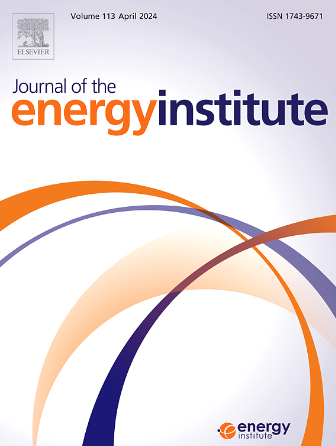中试规模往复式移动炉排炉中城市固体废物空气气化的实验评估
IF 5.6
2区 工程技术
Q2 ENERGY & FUELS
引用次数: 0
摘要
全球城市固体废物(MSW)数量的不断增加带来了巨大的环境挑战,因此有必要开发高效的废物变能源(WtE)解决方案。在各种热化学方法中,气化是将城市固体废物转化为合成气的一种有前途的方法,合成气可用于能源生产。本研究调查了 MSW 在中试规模往复式移动格栅炉中的气化特性,重点研究了等效比 (ER)、气化温度和气化剂阶段比等关键操作参数对气化特性的影响。在不同的 MSW 较低热值 (LHV) (从 6.98 到 15.1 MJ/kg)和吞吐量(从每天 0.77 到 1.67 吨)条件下测试了七种实验方案,以评估移动格栅系统在不同条件下的适应性和稳定性。结果表明,ER 值介于 0.6 和 0.7 之间、气化温度为 760 °C、气化剂分级比例为 7:3 是实现 71.6 % 最大能量转换效率的最佳条件。研究发现,当气化温度超过 850 ℃ 时,由于轻烃的氧化作用增加,合成气的 LHV 会降低。研究结果表明,虽然移动炉排系统的最大能量转换效率低于其他类型的反应器,但由于不需要专门的原料预处理,其资本和运营成本较低,因此是小规模和中试规模应用的可行选择。这项研究为优化 MSW 气化工艺提供了宝贵的见解,并强调了移动炉排炉在适应性强、成本效益高的 WtE 应用方面的潜力。这项工作的新颖之处在于在不同操作条件下对移动炉排气化过程进行了全面评估,为今后在大规模 MSW 管理中提高效率和减少环境影响的研究奠定了基础。本文章由计算机程序翻译,如有差异,请以英文原文为准。
Experimental evaluation of municipal solid waste air-gasification in a pilot-scale reciprocating moving-grate furnace
The increasing volume of municipal solid waste (MSW) worldwide presents significant environmental challenges, necessitating the development of efficient waste-to-energy (WtE) solutions. Among various thermochemical methods, gasification offers a promising approach for converting MSW into syngas, which can be utilized for energy generation. This study investigates the gasification characteristics of MSW in a pilot-scale reciprocating moving-grate furnace, focusing on the effect of key operating parameters such as equivalence ratio (ER), gasification temperature, and gasifying agent-staged ratio on gasification characteristics.
Seven experimental schemes were tested with varying lower heating values (LHV) of MSW (ranging from 6.98 to 15.1 MJ/kg) and throughputs (ranging from 0.77 to 1.67 tons per day) to assess the adaptability and stability of the moving-grate system under different conditions. The results indicate that an ER between 0.6 and 0.7, a gasification temperature of 760 °C, and a gasifying agent-staged ratio of 7:3 are optimal for achieving a maximum energy conversion efficiency of 71.6 %. It was observed that the LHV of syngas decreases when the gasification temperature exceeds 850 °C due to increased oxidation of light hydrocarbons. Moreover, the study highlights the influence of grate moving speed on residence time and reaction completeness, which are critical for optimizing syngas yield and quality.
The findings demonstrate that while the maximum energy conversion efficiency of the moving-grate system is lower than other reactor types, its lower capital and operating costs, due to the lack of dedicated feedstock pretreatment, make it a viable option for small-scale and pilot-scale applications. This study provides valuable insights into optimizing MSW gasification processes and underscores the potential of the moving-grate furnace for adaptable and cost-effective WtE applications. The novelty of this work lies in the comprehensive evaluation of the moving-grate gasification process under varied operating conditions, providing a foundation for future research on improving efficiency and reducing environmental impact in large-scale MSW management.
求助全文
通过发布文献求助,成功后即可免费获取论文全文。
去求助
来源期刊

Journal of The Energy Institute
工程技术-能源与燃料
CiteScore
10.60
自引率
5.30%
发文量
166
审稿时长
16 days
期刊介绍:
The Journal of the Energy Institute provides peer reviewed coverage of original high quality research on energy, engineering and technology.The coverage is broad and the main areas of interest include:
Combustion engineering and associated technologies; process heating; power generation; engines and propulsion; emissions and environmental pollution control; clean coal technologies; carbon abatement technologies
Emissions and environmental pollution control; safety and hazards;
Clean coal technologies; carbon abatement technologies, including carbon capture and storage, CCS;
Petroleum engineering and fuel quality, including storage and transport
Alternative energy sources; biomass utilisation and biomass conversion technologies; energy from waste, incineration and recycling
Energy conversion, energy recovery and energy efficiency; space heating, fuel cells, heat pumps and cooling systems
Energy storage
The journal''s coverage reflects changes in energy technology that result from the transition to more efficient energy production and end use together with reduced carbon emission.
 求助内容:
求助内容: 应助结果提醒方式:
应助结果提醒方式:


